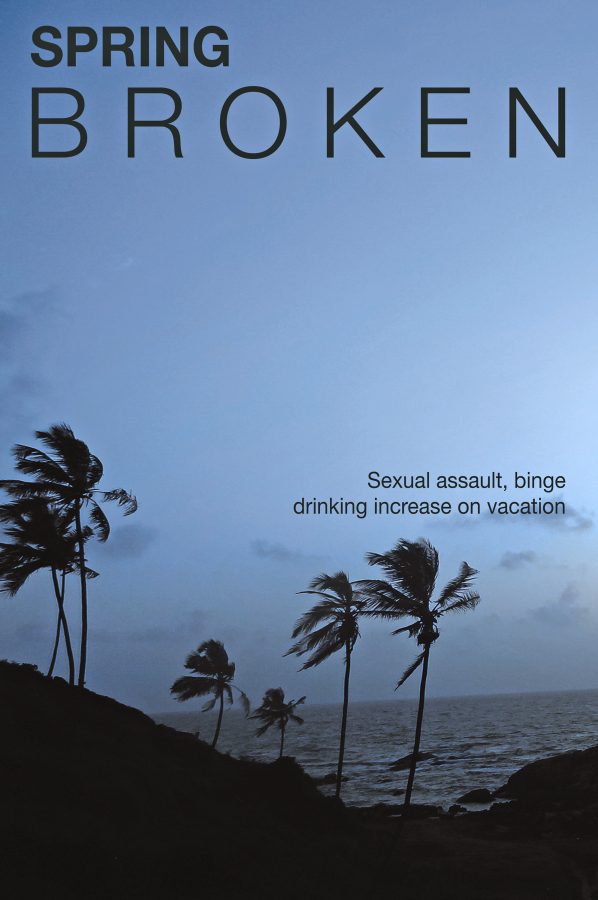Spring break has long been stereotyped for its non-stop party atmosphere. Every year, beaches and bars crowd with college students ready for some fun in the sun to take their minds off taxing schoolwork. But while students may escape the burden of class, they rarely escape the campus issues of substance abuse and sexual assault.
“We want a quick fix for stress, so we naturally turn to self-medicating with alcohol and other substances,” says Delynne Wilcox, an Assistant Director of the Health Planning & Prevention initiative of the Student Health Center. “Spring break ties into mental health and sexual assault, the whole gambit.”
Wilcox also said there was a perceived safety about marijuana, which often went hand in hand with alcohol consumption among college students, but she warned that health information was only just recently emerging on the drug.
While she is aware that many students drink frequently, students often shrug off even the slightest notion of responsibility during spring break, Wilcox said. The week of no classes often becomes the week of no rules, and that translates to trouble when students start ignoring the rules of alcohol safety.
“[You] can’t be insulated from negative consequences,” Wilcox said.
In the 2015 spring break period from March 1 to April 12, Panama City Beach Police Department responded to over 13,000 service calls leading to just above 2,400 arrests, Forbes reports. Of those, some 500 were drug-related. Often, officers were responding to shootings, assaults and alcohol poisonings.
Every year, 690,000 students between the age of 18 and 24 are the victim of alcohol-related assault, Forbes reports. Additionally, in that age group, 599,000 accidental injuries are reported, and 97,000 people become victims of alcohol-related sexual abuse.
In 2015, Panama City Beach made headlines when a woman was gang-raped in broad daylight on the beach while onlookers did nothing. The perpetrators were students at Troy University on their spring break.
According to a study conducted by the American College of Health, the average male attendee of spring break festivities consumed 18 alcoholic drinks in a day. The average female attendee consumed 10.
Sexual assault was a prominent part of the campaign platforms of all three SGA Presidential hopefuls in this past election. Unofficial SGA president-elect Jared Hunter’s campaign advocated the introduction of a new sexual-assault prevention app for students on campus. Campaigns like the “It’s On Us” initiative are designed to make sexual assault a more widely acknowledged issue on campus.
“People drink a lot more during spring break which increases rates of sexual assault,” said Marissa Cornelius, a junior secondary education and social sciences major. Marissa works with the Not On My Campus initiative to spread awareness about sexual assault and preventive measures that students can use to keep crime out of the mix.
“I did the whole beach Spring Break thing last semester,” said Cornelius. “It’s been my job to step in and say, ‘look, my friend is too drunk.’”
Cornelius credited her actions to bystander training that taught her when to respond to potentially risky situations. She said it was important for everyone to know about proper consent to avoid cases of sexual misconduct, and to be able to protect their friends from unwanted contact.
“A lot of people think that consent is just about not receiving a no, but it’s actually more about also receiving a yes; the absence of a no could just mean that they’re scared, or they’re too drunk,” said Cornelius.
The University Title IX office cautions that “if an individual is incapacitated due to alcohol, drugs, or other substances, the individual is not able to give consent for sexual activity.”
“The University encourages students to be active bystanders and assist in preventing sexual misconduct by recognizing situations of potential harm and taking actions to safely intervene in those situations,” University Title IX coordinator Beth Howard said.
A major issue with sexual assault is that even with today’s initiatives, many assaults still go unreported. The Title IX office urged that students are welcome and encouraged to report incidence of sexual assault even if it takes place off-campus or during class breaks.
According to PBS, a Justice Department report claims that only 20 percent of all on-campus sexual assaults are reported. Commonly cited statistics of the “It’s On Us” campaign state that one in four women and one in 16 men are victims of sexual assault during their college careers.
Additionally, the Justice Department report claimed that 80 percent of rapes were committed by perpetrators known to the victims. Wilcox said it is important to always stay in groups, and to ensure that at least one member of that group is sober at all points throughout the night. “Everyone deserves opportunities to enjoy Spring Break,” Wilcox said.
Wilcox also emphasized that the position of designated driver should be shared by everyone in spring break groups. Additionally, she stated it would not be a bad idea to have multiple people remain sober so that the burden of taking care of everyone did not fall on one person.
Wilcox said the Student Health Center has plenty of information on how to use alcohol safely, and the Title IX Office has information on how to be an active bystander.









